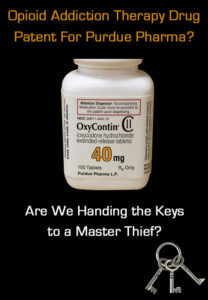written for Inspire Malibu

The stark reality of the opioid crisis in America is that more than 115 people die every day as a result of prescription painkillers, heroin and fentanyl. To put that tragic statistic into context, more people die in one year from opioid overdoses than American lives lost during the entirety of the Vietnam War.
So, a medication with the potential to help in the fight against opioid addiction should be welcomed news. This time, however, some observers are not so sure.
Richard Sackler, a member of the family that owns Purdue Pharma, creators of the opioid painkiller OxyContin, was awarded a patent in January 2018 for a new faster-acting type of buprenorphine, a drug used to treat opioid addiction.
“…the patent could enable Sackler to benefit financially from the addiction crisis that his family’s company is accused of fueling,” writes STAT news contributor Andrew Joseph.
The drug-maker is already being sued in more than a 1,000 counties around the country for its role in driving the opioid epidemic through misleading marketing that OxyContin wasn’t addictive. In 2007, a federal court ruled that top executives at Purdue pay $630 million fines for these crimes. That fine, though, did little to effect the $31 billion the company made from selling the painkiller that year.
Buprenorphine, which has shown promise in opioid addiction treatment, is already on the market in different forms. The medication comes in pill form, a sublingual pill and even as time-release implants, called Probuphine.
The medication, which is only available by prescription, helps ease cravings and withdrawal symptoms in some of the following ways:
- The medication binds to opioid receptors in the body
- Opioid receptors are then satisfied, though without releasing high-levels of euphoric inducing dopamine or causing significant respiratory depression
- Buprenorphine also acts as something of a shield, blocking additional opioids from bonding with receptors, so that a person on the medication is unlikely to experience a “high” if they use heroin or prescription painkillers
Sackler’s patent application acknowledges the ongoing opioid crisis, and argues that a fast-dissolving buprenorphine wafer would prevent people from removing pills or the sublingual form of the medication from their mouths, ultimately aiding in treatment and recovery if it’s eventually approved by the Federal Food and Drug Administration (FDA) and brought to market.
Other research is focused on creating non-addictive pain medications that could, potentially, end or limit the need for highly addictive opioid painkillers.
Blue-181 is a synthetic molecule that’s 50 times more powerful than morphine and works by targeting pain receptors in the spinal chord that reduce the perception of pain. Though it’s not currently on the market, research for this medication is supported by the National Institutes of Health and the Department of Defense. Researchers hope to be in clinical trials soon.
In the meantime, the opioid epidemic rages virtually unimpeded. Even amidst its legal battles and fines, Purdue Pharma shipped 21 million opioid painkillers to a small West Virginia town – population 2,900 – between 2006 and 2016, crippling an already troubled state.
Handing a patent for opioid addiction treatment a member of the family that owns Purdue, according to critics, seems like offering a jewelry thief the combination to the safe.
